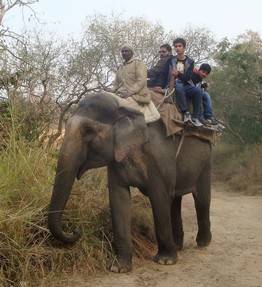 Tiger Census
Tiger Census
The census is conducted scientifically after every five years the numbers are encouraging, and the population in fifty tiger reserves and outside together stand at 2967 constituting seventy-five percent of the global population. The census is nearly accurate using camera traps, historical evidence, reports, and much more.
Protection Mechanism
All viable habitats are being reclaimed/developed and turned into tiger reserves. The mechanism of protection is the strongest in the core areas, and weak in the outer rings or buffers where fewer cats exist...
In core areas, human habitation is not allowed only the workforce lives there. No commercial activities are permitted except controlled tourism in twenty percent of the core. In recent times tourism is also organized in forests with good crown cover in the outer ring.
Sentinels of Wild
All through the tiger reserves pan India, fire watchers' huts and anti-poaching camps have been established to protect the animals and the forests. Subject to intense patrolling and alacrity the poaching incidence has been successfully mitigated to a great extent. Overall attention paid to wildlife conservation is paying rich dividends. The forest staff and wildlife managers are committed and dedicated to their tasks with sincerity, hence the population is recovering in most of the reserves.
Conservation Initiatives
Tiger conservation in the country is all-encompassing and holistic thanks to scientific institutions, able wildlife managers, and foot soldiers the sentinels of the wild.
Tourism has empowered local communities through skills and finances. They have become part of additional support systems proudly aiding the conservation of their heritage. A tide has been turned for saving the tiger in India.
Role of NGOs
NGOs like the WPSI have fought tooth and nail against the poachers. Funds from WWF for nature and other institutions have been extremely helpful. Local NGOs and village-level societies too contribute towards habitat and wildlife protection by being part of the system.



 The hunting menace started with the arrival of the British in India, besides erstwhile Maharajahs & Nawabs, and continued with greater menace post-independence. Many hunting companies had taken a foothold in the country by then. They became revenue earners, for a paltry sum one could hunt the beast, while the companies organized the trips.
The hunting menace started with the arrival of the British in India, besides erstwhile Maharajahs & Nawabs, and continued with greater menace post-independence. Many hunting companies had taken a foothold in the country by then. They became revenue earners, for a paltry sum one could hunt the beast, while the companies organized the trips. 



 Tiger Census
Tiger Census 

 Tourism is an appreciable source of revenue generation. This revenue is plowed back into conservation, and park maintenance. Funds are also contributed by the Central and State Governments besides many NGOs.
Tourism is an appreciable source of revenue generation. This revenue is plowed back into conservation, and park maintenance. Funds are also contributed by the Central and State Governments besides many NGOs.




 Full Day Safari in Bandhavgarhon 08/29/2023
Full Day Safari in Bandhavgarhon 08/29/2023
 SEO Campaign: Website Overhaulon 02/13/2023
SEO Campaign: Website Overhaulon 02/13/2023
 Indian Food It Is Not All Curryon 02/08/2023
Indian Food It Is Not All Curryon 02/08/2023
 How Tiger Tourism is Organized in India?on 02/07/2023
How Tiger Tourism is Organized in India?on 02/07/2023



Comments
Tigers are majestic animals yes.
Read More About Them
https://tigersafari.blogspot.com/
Thanks!
Tigers are superb animals. I'd love to learn more about them. It's so wonderful when these wild animals have a habitat to call their own, and so natural, in fact! That 1972 is quite marvelous and necessary. Incidentally, I find zoos terribly depressing, and wish there were more ways for kids and adults to see these animals in the wild.
That is the way the World goes!
Humans should die naturally, killing humans is only justifiable as a last resort to prevent a greater evil.
Pug marks counting was relied upon before technology stepped in. It along with hidden camera and scientific calculations the census is now more accurate however tigers are mysterious animals and hundred percent accuracy is difficult to reach. The numbers in India at present juncture are growing. Thanks for the comment!
Pug marks counting was relied upon before technology stepped in. It along with hidden camera and scientific calculations the census is now more accurate however tigers are mysterious animals and hundred percent accuracy is difficult to reach. The numbers in India at present juncture are growing. Thanks for the comment!
All life forms deserve respect and care!
When you kill wild animal for food make sure their population is much over the brink. In India there is complete ban on hunting wildlife since 1972. The country is strong on vegetarian ethos hence the ban. Wildlife is slowly bouncing back. Thanks for the comment.
When you kill wild animal for food make sure their population is much over the brink. In India there is complete ban on hunting wildlife since 1972. The country is strong on vegetarian ethos hence the ban. Wildlife is slowly bouncing back. Thanks for the comment.
pateluday, Thank you for the practical information, pretty pictures and product lines.
Did the census takers and analysts know at the time that pug mark counting is flawed? Is it possible that that was the only means to be carried out at the time or was it the cheapest and easiest?
It's reassuring to know that big cats are being saved in the subcontinent since it appears to me from their pictures that they like their Indian habitats.